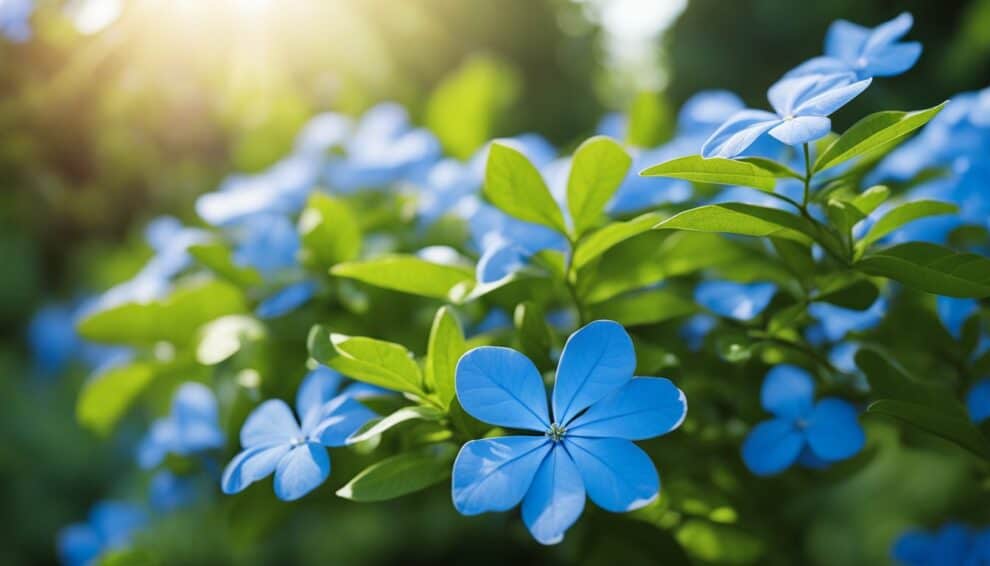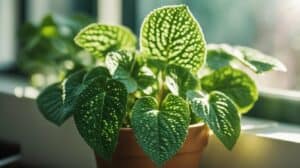Ceratostigma plumbaginoides, commonly known as the plumbago plant, is a beautiful and easy-to-grow perennial that is perfect for beginner gardeners.
This plant is native to China and produces stunning blue flowers that bloom from late summer to early fall.
The plumbago plant is also known for its attractive foliage, which turns a vibrant red in the fall.

The plumbago plant is a great addition to any garden, as it is both low-maintenance and versatile.
It can be used as a groundcover, border plant, or even in container gardens. This plant prefers full sun to partial shade and well-draining soil.
It is also drought-tolerant, making it a great choice for areas with hot summers. With proper care, the plumbago plant can thrive for many years.
Getting to Know Ceratostigma Plumbaginoides
Origin and Description
Ceratostigma Plumbaginoides, also known as the Plumbago plant, is a species of flowering plant in the family Plumbaginaceae.
This plant is native to China and is widely cultivated in many parts of the world.
The plant is a small perennial shrub that grows up to 12 inches tall and spreads up to 18 inches wide.
It has a low, spreading growth habit and produces small, deep blue flowers that bloom in late summer and early fall.
The leaves of the Ceratostigma Plumbaginoides are oval-shaped and have a glossy, dark green color.
They turn a beautiful reddish-purple color in the fall before they drop off.
The plant is also known for its attractive bark, which is a reddish-brown color and peels off in thin strips.
Species Varieties and Relatives
There are several varieties of Ceratostigma Plumbaginoides, including ‘Covington Blue’, which has larger flowers than the species and ‘Forest Blue’, which has a more compact growth habit.
Ceratostigma Plumbaginoides is closely related to other plants in the family Plumbaginaceae, including the Plumbago auriculata, also known as the Cape Leadwort.
This plant is native to South Africa and has similar blue flowers and glossy green leaves.
Overall, Ceratostigma Plumbaginoides is a beautiful and easy-to-grow plant that is perfect for beginners.
It is low maintenance and can be grown in a variety of conditions, making it a versatile addition to any garden.
Cultivation Essentials

Ideal Growing Conditions
Ceratostigma Plumbaginoides, commonly known as Plumbago, is a hardy perennial plant that can thrive in a variety of growing conditions.
However, for optimal growth and blooming, it is best to provide it with the following ideal growing conditions:
- Light: Plumbago requires full sun to partial shade for at least 6 hours a day.
- Soil: The plant prefers well-draining, fertile soil with a pH between 6.0 and 7.5.
- Temperature: Plumbago can tolerate a wide range of temperatures, from -10°C to 40°C.
- Humidity: The plant can tolerate low humidity levels, but it prefers moderately humid conditions.
- Air Circulation: Good air circulation is essential to prevent fungal diseases.
Planting Tips
Plumbago is easy to grow and care for, making it an excellent choice for beginner gardeners. Here are some planting tips to help you get started:
- Timing: The best time to plant Plumbago is in the spring or early fall.
- Spacing: Space the plants 30cm apart to allow for proper air circulation and growth.
- Planting Depth: Plant the root ball at the same depth as it was in the container.
- Mulching: Mulch around the base of the plant to retain moisture and suppress weeds.
Watering and Feeding Requirements
Plumbago requires moderate watering and feeding to thrive. Here are some guidelines to follow:
- Watering: Water the plant deeply once a week, or more often during hot, dry weather. Avoid overwatering, as it can lead to root rot.
- Feeding: Fertilize the plant with a balanced, slow-release fertilizer in the spring and midsummer.
Avoid overfertilizing, as it can lead to excessive foliage growth and reduced blooming.
By providing your Plumbago with the ideal growing conditions, proper planting techniques, and adequate water and nutrients, you can enjoy its beautiful blue flowers and lush foliage for years to come.
Maintenance and Care

Ceratostigma plumbaginoides is a low-maintenance plant that is easy to care for.
However, proper maintenance is essential to keep the plant healthy and thriving. Here are some tips for maintaining and caring for this beautiful plant.
Pruning and Shaping
Pruning and shaping are essential for maintaining the shape and size of the plant. Prune the plant in early spring before new growth appears.
Cut back any dead or damaged branches to the ground level. You can also prune the plant to control its size and shape.
Use sharp pruning shears to make clean cuts and avoid damaging the plant.
Pest and Disease Management
Ceratostigma plumbaginoides is generally resistant to pests and diseases. However, it can be susceptible to fungal diseases in humid conditions.
To prevent fungal diseases, avoid overhead watering and provide good air circulation around the plant.
If you notice any signs of fungal disease, such as yellow or brown spots on the leaves, remove the affected leaves and dispose of them in the trash.
The plant can also be affected by pests such as spider mites and aphids. To control pests, spray the plant with a solution of water and mild soap.
You can also use insecticidal soap or neem oil to control pests. Be sure to follow the manufacturer’s instructions when using any chemical treatments.
Overall, Ceratostigma plumbaginoides is a low-maintenance plant that is easy to care for.
With proper maintenance and care, you can enjoy this beautiful plant for years to come.
Landscape Uses and Companion Plants

Ceratostigma Plumbaginoides is a versatile plant that can be used in a variety of landscape settings.
Its low-growing habit and spreading growth make it an excellent choice for groundcover in sunny areas.
It can also be used as an edging plant, planted along paths, or in rock gardens.
This plant is also a great companion for other sun-loving perennials, such as Sedum, Coreopsis, and Echinacea.
Its blue flowers and green foliage provide a nice contrast to the yellow and orange flowers of these plants.
It also pairs well with ornamental grasses, such as Pennisetum and Miscanthus.
For a more formal look, Ceratostigma Plumbaginoides can be planted in mass as a border plant or in a container garden.
It also looks great when planted in combination with other blue-flowering plants, such as Salvia and Delphinium.
Overall, Ceratostigma Plumbaginoides is a great plant for adding color and interest to any garden or landscape.
Its versatility and low-maintenance nature make it an excellent choice for beginners and experienced gardeners alike.
Frequently Asked Questions

How do you care for a hardy plumbago shrub?
Ceratostigma plumbaginoides is a hardy plant that requires minimal maintenance. It prefers well-drained soil and partial to full sun exposure.
Water the plant regularly during the growing season but avoid overwatering, as it can lead to root rot.
Fertilize the plant once a year with a balanced fertilizer in early spring.
What are the best companion plants for plumbago?
Plumbago pairs well with other sun-loving perennials such as coneflowers, black-eyed Susans, and asters.
It also looks great when planted alongside ornamental grasses, such as feather reed grass or switchgrass.
Can Ceratostigma plumbaginoides be grown from seeds?
Yes, plumbago can be grown from seeds, but it can be a slow process. It is easier to propagate the plant through division or cuttings.
Is plumbago a perennial, and what are its zone requirements?
Yes, Ceratostigma plumbaginoides is a perennial plant. It is hardy in zones 5-9, but it may need some winter protection in colder areas.
What are the different plumbago varieties available?
There are several plumbago varieties available, including Ceratostigma willmottianum, Ceratostigma griffithii, and Ceratostigma plumbaginoides ‘Blue Paradise.’ Each variety has its own unique characteristics, such as flower color and growth habit.
Should you cut back Ceratostigma plumbaginoides, and if so, when?
It is recommended to cut back plumbago in late winter or early spring before new growth appears. This will help promote bushier growth and more blooms.
However, avoid cutting back too much, as it can delay blooming.














